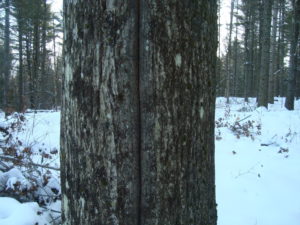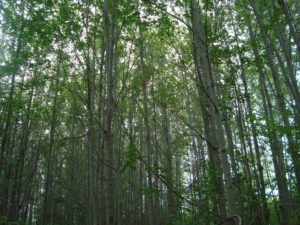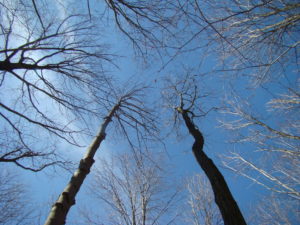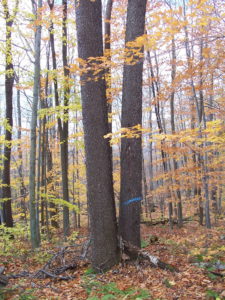The Benefit of Markets for Managing Low-Grade Trees
Low-grade trees may be aesthetically attractive and have other than economic benefits.
Considerable attention is given to high-value trees, particularly how to grow them and their value when harvested. The harvest of just the high-value trees from a woodland is known as high-grade harvesting, selective cutting, or simply “high-grading.” This unsustainable practice has also been discussed because it diminishes the ecological and financial value of a woodlot. In almost every conversation about high-value or high-grade trees there is also a discussion of the conundrum for how to also manage (i.e., harvest and sell or otherwise kill) the low-value or low-grade trees.
A low-grade tree is a tree with little or no financial value because it has poor form (e.g., crooked stems), excessive defect (e.g., splits, knots), and/or is a species that has little or no economic value (e.g., American beech, eastern hophornbeam). Low-grade trees may be aesthetically attractive and have other than economic benefits, but they exist in the forest where they compete for sunlight with other species that have financial value and also have aesthetic and ecological value. In the high-grade harvesting scenario, the retention of low-grade trees as the predominant quality of tree may prevent the regrowth of more desirable trees and provide a disproportionate abundance of seed that will dominate the next forest. The low-grade trees may also grow more slowly and limit some ecological services such as the accumulation, or sequestration, of carbon.

A hardwood tree that would otherwise have value except for the split caused by an injury or frost crack. Trees are exposed to numerous potential injuries that can reduce their value.
Courtesy of Peter Smallidge
The Origins of Low-Grade
A reasonable starting point to understand the management and markets of low-grade trees is their presence in the development of the forest. As young forests develop, whether in small patches or large openings, there are initially thousands of stems per acre. As trees grow they compete with other trees for sunlight. Most of the trees initially present as seedlings will die by the time the forest matures. Those trees that survive represent a subset of the initial mixture of species. Some of those species have high economic value and others do not. The species that survive will have a variety of forms and qualities that result from their genetics, any injuries they sustained, and their ability to thrive on the soils and in the growing space where they were located. Some stems will have their crown in the upper canopy and have good access to sunlight, while other stems are relegated to the lower canopy where they struggle for sunlight. A stem might be a species of high value, such as black cherry or sugar maple, but might in actuality be a low-grade tree as a result of bad genetics or bad luck. Without management intervention, the majority of stems in the mature woodland will have minimal to low economic value and all trees are growing more slowly than they might grow.
The sunlight that shines onto an acre of forest is captured by trees through the process of photosynthesis. As a result of photosynthesis, oxygen is released and carbon is stored in the production of new wood. In a forest where low-grade trees have been controlled through management activities, the residual higher value trees capture a greater proportion of the sunlight and more quickly accumulate wood. These higher value trees have high value because they are desired for high value wood products (e.g., cabinets, fine furniture, floors) that have a long life span.
The Benefits of Managing Low-Grade Trees

This former agricultural field was abandoned and regrew to mostly red maple. The canopy has closed and trees are competing for sunlight. Some are winning, others losing. Some have developed defects that will make them of low value.
Courtesy of Peter Smallidge
Managing low-grade trees requires a significant effort. Recall that an acre of semi-mature or mature woodland may have a few hundred low-grade trees. Management means that those stems are killed, so as to remove their competitive presence relative to neighboring high-value stems. Ideally the low-grade stems can be harvested and sold. Selling low-grade trees, given their number, the effort necessary to handle them, and the availability of markets is an enterprise with small economic margins for the logging contractor. The efficiency of operations and fair markets are essential. Without a market, management activities will need to kill the trees by mechanically felling or girdling, or through the injection of a small dose of an herbicide. These trees eventually break down or decompose and release carbon, which is absorbed by trees and completes the carbon cycle.
The management of low-grade trees thus has a benefit of allowing for faster growth on high-value trees, and also several other benefits. One benefit is that although the trees are of low value, they have some value where markets exist. Those trees can be sold through a harvest that reduces competition for sunlight and increases the growth rate and thus value of the residual trees in the owner’s woods. The low-grade harvest may provide modest revenue to the owner, the benefit of a more productive woodland without direct cost or effort to the owner, or avoidance of more costly activities that kill but do not utilize the stems.

This previously unmanaged woods has trees that have survived competition for light, but haven’t necessarily thrived. Many have weak crowns, poor stem quality and form and thus are considered low-grade.
Courtesy of Peter Smallidge
In addition to this increased value through better productivity on higher value trees, after the harvest or management activity those residual trees are more quickly accumulating wood. That wood, which is about 50% carbon by weight, will be desirable for durable, long-lasting wood products. The sequestration of carbon is considered an ecosystem benefit or service that is provided by woodland owners. Eventually, with a healthy forest economy, the higher value trees can be sold for long-lived durable wood products.
Another benefit is that the removal of low-grade trees will change the “look” of the forest, known as forest structure or the relative abundance of trees of different sizes. The preponderance of larger and healthy trees is attractive to many people who enjoy the cathedral-like appearance of the managed forest. Beyond the human aesthetic, the more open woodland offers a different habitat because of a slightly more open canopy, reduced mid-canopy, and increased sunlight to the forest floor that allows for the growth of understory plants.
Low-grade management also increases forest resilience, which is the ability to recover from stress. Stress events such as drought, ice storms, and insect defoliation interfere with normal physiological functions of the tree that reduce their ability to grow and create defensive compounds. In the unmanaged forest, the slower growth of trees makes them less resilient and thus more vulnerable to mortality than if they were growing vigorously at the time of stress. Removing low-grade trees allows the residual trees to be more vigorous, removes stunted or structurally unstable stems, and creates a forest that as a whole is more resilient.
A forest or woodland that is exploitatively logged through high-grading, which disregards the consequences of having an abundance of low-grade trees, engenders several potential problems. These include the loss of sufficient economic leverage to conduct future desired or necessary management actions, such as control of invasive species, forest health and resiliency improvements, or installation or maintenance of water quality best management practices. Ecologically, the potential problems following high-grading include reduced species diversity, reduced tree growth and thus reduced accumulation of carbon, and lowered resilience to future biological or environmental perturbations.

Good forestry practices will remove low-value, low-vigor and trees without longevity to favor the growth of vigorous upper canopy and valuable trees. The lesser of the two black cherry stems is marked for harvest. Courtesy of J. Michael
There are thousands of private woodland owners who in the aggregate influence the majority of the ecosystem services provided by New York’s forests to society. The management of low-grade trees requires effort and incurs expense. While a small fraction of owners manage their low-grade trees through personal activity such as firewood cutting, most other woodland owners rely on logging contractors or public subsidy. Public subsidy is limited, costly, and historically impacts a small percentage of the private woodland acreage. Logging contractors can manage low-grade, but like any business need to be compensated for their effort and investments either through reduced payments to owners for high-value timber, or by options to sell the low-grade into markets.
Perhaps the greatest obstacle for the management of low-grade is the availability of markets. Traditional markets, which have either quickly saturated as forests mature or continually diminished, include wood for pulp and paper manufacturing, firewood, chips for manufactured goods (e.g., oriented strand board or OSB; furniture casings), and other localized niche markets (e.g., pallets, landscape ties, etc.). Some new markets have emerged for thermal outputs, such as fuel chips and pellets, but those markets are limited and are quickly satisfied by the available supply.
The intersection of low-grade management and low-grade markets ripples impacts that have broad societal consequences. The low-grade tree resource is available for expanded markets, the logging community recognizes the importance of this type of management, and most owners understand the principle of “weeding the woods.” The intersection is really an opportunity to use an abundant resource that can benefit owners, businesses and communities. The missing link is an ability to develop reliable markets that sustain the needs of the supply side and the demand side.

